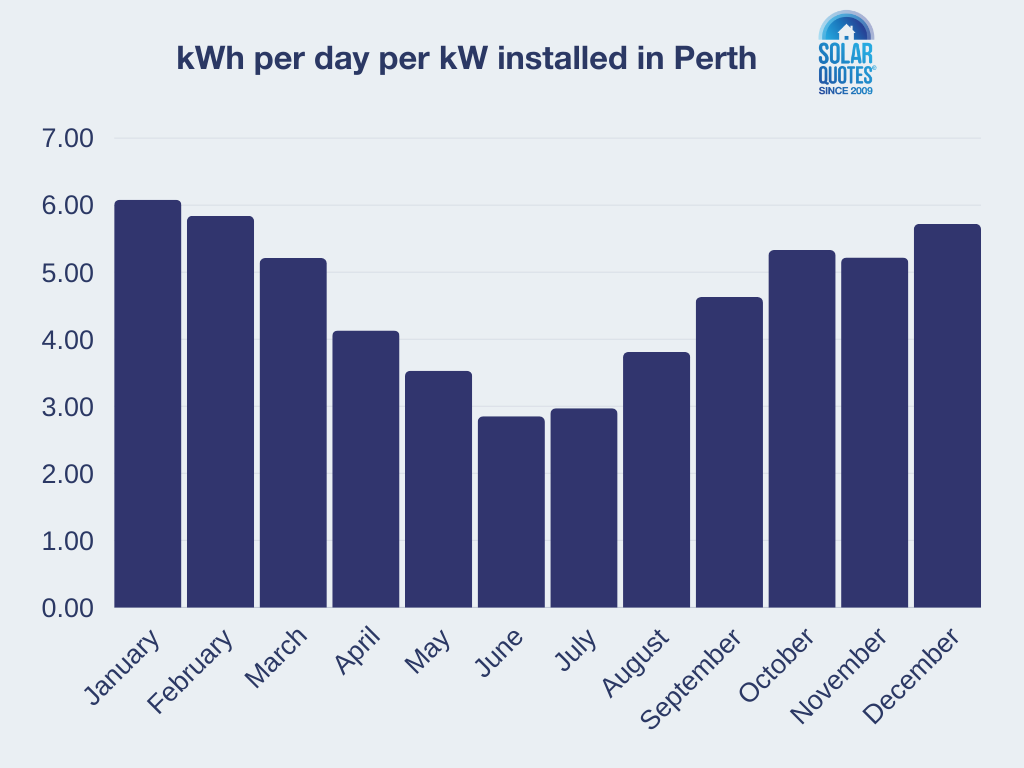Perth Climate
Perth, the capital of Western Australia, enjoys a Mediterranean climate with hot, dry summers and mild, wet winters. The average high temperature in January is 30.3°C, while July sees average lows of 8°C. This sunny climate makes Perth an excellent location for solar power.
Solar Energy Potential in Perth
Perth is one of the sunniest cities in Australia, with each kilowatt of solar panels generating approximately 4.61 kilowatt-hours of electricity daily. This makes it an ideal location for solar power systems. A typical 6.6-kilowatt solar system on a north-facing roof in Perth can generate about 27.66 kilowatt-hours of electricity daily or 11,105 kilowatt-hours annually.
The following graph illustrates the solar energy variation across the year, showing the average daily kWh production per installed kW for each month.

Solar Panel Direction and Output in Perth
Solar panels facing north will generally produce the highest electricity output in Perth. However, panels oriented east or west can also be effective, particularly if they better match your household’s electricity usage patterns. East-facing panels generate more energy in the morning while west-facing panels produce more in the afternoon. This alignment can increase the self-consumption of solar power, thus decreasing dependency on grid electricity.
Here is a table that illustrates how different roof directions and tilts impact solar output in Perth compared to the optimal north-facing, 30-degree orientation:
| | 0° | 10° | 20° | 30° | 40° | 50° | 60° | 70° | 80° | 90° |
|---|
| N |
88% |
94% |
98% |
100% |
99% |
95% |
89% |
81% |
72% |
61% |
| NE |
88% |
92.5% |
95% |
95% |
94% |
90.5% |
85% |
79% |
70.5% |
62% |
| E |
88% |
88% |
87% |
84% |
81% |
77% |
72% |
66% |
60% |
54% |
| SE |
88% |
83.5% |
78% |
71.5% |
64% |
57% |
40.5% |
44.5% |
40% |
35.5% |
| S |
88% |
82% |
74% |
65% |
55% |
46% |
38% |
31% |
26% |
24% |
| SW |
88% |
84% |
78% |
71.5% |
64.5% |
57.5% |
51.5% |
45.5% |
40.5% |
36% |
| W |
88% |
88% |
87% |
85% |
81% |
77% |
72% |
67% |
60% |
54% |
| NW |
88% |
92.5% |
95% |
96% |
94% |
91% |
86% |
79% |
70.5% |
62% |
Maximum Solar System Size in Perth
Perth households with single-phase power can install systems up to 10 kilowatts (kW) with a 5 kW export limit. Homes with three-phase power can install up to 15 kW of solar inverters. Systems over 10 kW may require council approval. These limits refer to the inverter size, not the total solar panel capacity, allowing for oversizing – installing more panels than the inverter's rated capacity. This maximizes solar production during less optimal conditions, enhancing overall efficiency and savings.
Roof Angle and Solar Panel Tilt in Perth
In Perth, the best angle for solar panels is 29 degrees. Most roofs in Australia have a pitch of 15 or 22.5 degrees, though some can be as steep as 30 degrees or more. The difference in electricity output between a shallow 15-degree roof and a steep 45-degree roof is relatively small. Shallow roofs tend to favour energy production in the summer, while steeper roofs are more efficient in winter. For instance, panels on a 45-degree roof generate about 9% less electricity in January and 20% more in July than those on a 15-degree roof.
Solar Feed-In Tariffs in Perth
Feed-in tariffs in Perth are set by Synergy and Horizon Power. Off-peak rates start at 2 cents per kilowatt-hour but in peak times you can get up to 10 cents per exported kWh. The right plan depends on your energy consumption and solar generation patterns.
Savings from Rooftop Solar Panels in Perth
A Perth household installing a 6.6 kW north-facing solar system can expect substantial savings. With a 2-cent feed-in tariff, an average Perth electricity price of $0.29/kWh and 40% self-consumption, annual savings can reach around $1,421. With a higher feed-in tariff, such as 10 cents, savings can increase to approximately $1,954 annually.
Self-Consumption of Solar Electricity
Maximising self-consumption is essential for enhancing the economic benefits of solar power. This can be achieved by operating appliances like dishwashers, hot water systems, and pool pumps during daylight hours. Additionally, setting air conditioners to cool or heat your home before you return can further increase self-consumption, making the most of the electricity generated by your solar panels.
Solar Uptake in Western Australia
Western Australia has seen significant growth in solar power adoption. 36% of WA homes have solar panels, and it's predicted that half of Perth’s households could have solar panels within the next few years.
Solar Power as Part of the Energy Mix in Western Australia
As of February 2023 residential solar provides 64% of WA's electricity needs in the middle of the day.
Rooftop solar power systems are a significant part of Western Australia's energy mix, providing a substantial portion of the state's electricity. They help reduce carbon emissions and give households greater control over their electricity costs. Perth’s electricity prices have been increasing since 2017 and are expected to continue rising, making solar power an attractive option for mitigating these costs.
Conclusion
Perth offers excellent solar energy potential with its sunny climate and supportive environment. By choosing a suitable solar system and optimising panel placement, Perth residents can significantly reduce their electricity bills and contribute to a greener future.
![]() Please choose
Please choose